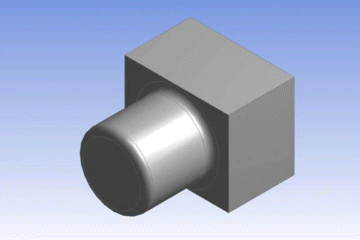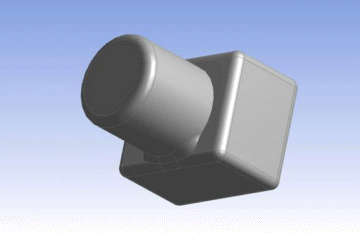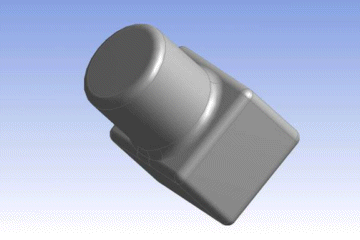NOTE 1: When selecting edges to blend/chamfer, if an edge you select ends where another edge is tangent to it, it can cause problems if you do not select the tangent edge as well. If the blend/chamfer would fail without the extra edge selected, the algorithm will sometimes continue with the blend/chamfer along the unselected edge in an attempt to cap the blend, which can sometimes produce an unexpected result or may fail. In these case, the result will be much more reliable if the tangent edge is also selected.
NOTE 2: With Blend (as well as Chamfer), processing is done on each connected set of edges separately. When the results from blending (or chamfering) these separate groups of edges overlap, it can sometimes cause problems and results may vary depending on the order that edges are selected.
For example, here is a simple example using a block and a cylinder. The block has 12 edges and the cylinder has two edges:

If all the edges are selected, starting with the cylinder first and then the block, the edges will be processed in three groups. Each circular edge of the cylinder will be processed separately as they to not connect with any other edges, then all 12 edges of the block will be processed as a single group as they all connect. Here is the result of selecting the cylindrical edges first:

Notice that the edges of the block are not blended. This is because the algorithm failed when trying to blend the two block edges that are closest to the cylinder, due to the overlapping blends. If instead, the edges of the block are selected first, here is the result:

Here notice that the block is blended, as well as the top of the cylinder, but the results at the base of the cylinder are a little strange. In this case, after blending all of the block edges, when it attempted to blend the bottom of the cylinder it again ran into an overlap situation. However, in this order, the algorithm was able to produce a partial blend of the edge. Overall, the different selection order has a significant change. In this case since there is part of the base of the cylinder that is still not blended, a second Blend feature can be created that selects the remaining circular edge, which provides the following result:

Even with overlaps, a complete blend is possible, but order is important. This is also true for Chamfer features.
forms:


